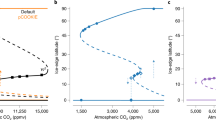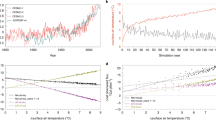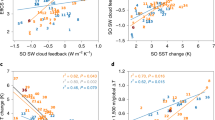Abstract
Earth has had oceans for nearly four billion years1 and Mars had lakes and rivers 3.5–3.8 billion years ago2. However, it is still unknown whether water has ever condensed on the surface of Venus3,4 because the planet—now completely dry5—has undergone global resurfacing events that obscure most of its history6,7. The conditions required for water to have initially condensed on the surface of Solar System terrestrial planets are highly uncertain, as they have so far only been studied with one-dimensional numerical climate models3 that cannot account for the effects of atmospheric circulation and clouds, which are key climate stabilizers. Here we show using three-dimensional global climate model simulations of early Venus and Earth that water clouds—which preferentially form on the nightside, owing to the strong subsolar water vapour absorption—have a strong net warming effect that inhibits surface water condensation even at modest insolations (down to 325 watts per square metre, that is, 0.95 times the Earth solar constant). This shows that water never condensed and that, consequently, oceans never formed on the surface of Venus. Furthermore, this shows that the formation of Earth’s oceans required much lower insolation than today, which was made possible by the faint young Sun. This also implies the existence of another stability state for present-day Earth: the ‘steam Earth’, with all the water from the oceans evaporated into the atmosphere.
This is a preview of subscription content, access via your institution
Access options
Access Nature and 54 other Nature Portfolio journals
Get Nature+, our best-value online-access subscription
$29.99 / 30 days
cancel any time
Subscribe to this journal
Receive 51 print issues and online access
$199.00 per year
only $3.90 per issue
Buy this article
- Purchase on Springer Link
- Instant access to full article PDF
Prices may be subject to local taxes which are calculated during checkout




Similar content being viewed by others
Data availability
The data that support the findings of this study are available at https://doi.org/10.5281/zenodo.4680905. Source data are provided with this paper.
Code availability
The LMD Generic global climate model code (and documentation on how to use the model) used in this work can be downloaded from the SVN repository at https://svn.lmd.jussieu.fr/Planeto/trunk/LMDZ.GENERIC/ (version 2528). More information and documentation are available at http://www-planets.lmd.jussieu.fr.
References
Catling, D. C. & Zahnle, K. J. The Archean atmosphere. Sci. Adv. 6, eaax1420 (2020).
Haberle, R. M., Catling, D. C., Carr, M. H. & Zahnle, K. J. in The Atmosphere and Climate of Mars (eds Haberle, R. M. et al.) 526–568 (Cambridge Planetary Science, Cambridge Univ. Press, 2017).
Hamano, K., Abe, Y. & Genda, H. Emergence of two types of terrestrial planet on solidification of magma ocean. Nature 497, 607–610 (2013).
Way, M. J. et al. Was Venus the first habitable world of our Solar System? Geophys. Res. Lett. 43, 8376–8383 (2016).
Bézard, B. & de Bergh, C. Composition of the atmosphere of Venus below the clouds. J. Geophys. Res. Planets 112, E04S07 (2007).
Phillips, R. J. et al. Impact craters and Venus resurfacing history. J. Geophys. Res. 97, 15923–15948 (1992).
Kreslavsky, M. A., Ivanov, M. A. & Head, J. W. The resurfacing history of Venus: constraints from buffered crater densities. Icarus 250, 438–450 (2015).
Wordsworth, R. D., Kerber, L., Pierrehumbert, R. T., Forget, F. & Head, J. W. Comparison of “warm and wet” and “cold and icy” scenarios for early Mars in a 3-D climate model. J. Geophys. Res. Planets 120, 1201–1219 (2015).
Wordsworth, R. D. The climate of early Mars. Annu. Rev. Earth Planet. Sci. 44, 381–408 (2016).
Kite, E. S. Geologic constraints on early Mars climate. Space Sci. Rev. 215, 10 (2019).
Way, M. J. & Del Genio, A. D. Venusian habitable climate scenarios: modeling Venus through time and applications to slowly rotating Venus-like exoplanets. J. Geophys. Res. Planets 125, e06276 (2020).
de Bergh, C. et al. Deuterium on Venus: observations from Earth. Science 251, 547–549 (1991).
Marcq, E., Mills, F. P., Parkinson, C. D. & Vandaele, A. C. Composition and chemistry of the neutral atmosphere of Venus. Space Sci. Rev. 214, 10 (2018).
Kasting, J. F. & Pollack, J. B. Loss of water from Venus. I. Hydrodynamic escape of hydrogen. Icarus 53, 479–508 (1983).
Kasting, J. F. Runaway and moist greenhouse atmospheres and the evolution of Earth and Venus. Icarus 74, 472–494 (1988).
Salvador, A. et al. The relative influence of H2O and CO2 on the primitive surface conditions and evolution of rocky planets. J. Geophys. Res. Planets 122, 1458–1486 (2017).
Charnay, B. et al. Exploring the faint young Sun problem and the possible climates of the Archean Earth with a 3-D GCM. J. Geophys. Res. Atmos. 118, 10414–10431 (2013).
Wolf, E. T. & Toon, E. B. Hospitable Archean climates simulated by a general circulation model. Astrobiology 13, 656–673 (2013).
Leconte, J., Forget, F., Charnay, B., Wordsworth, R. & Pottier, A. Increased insolation threshold for runaway greenhouse processes on Earth-like planets. Nature 504, 268–280 (2013).
Wolf, E. T. & Toon, O. B. Delayed onset of runaway and moist greenhouse climates for Earth. Geophys. Res. Lett. 41, 167–172 (2014).
Charnay, B., Wolf, E. T., Marty, B. & Forget, F. Is the faint young Sun problem for Earth solved? Space Sci. Rev. 216, 90 (2020).
Pierrehumbert, R. T. Thermostats, radiator fins, and the local runaway greenhouse. J. Atmos. Sci. 52, 1784–1806 (1995).
Elkins-Tanton, L. T. Linked magma ocean solidification and atmospheric growth for Earth and Mars. Earth Planet. Sci. Lett. 271, 181–191 (2008).
Lebrun, T. et al. Thermal evolution of an early magma ocean in interaction with the atmosphere. J. Geophys. Res. Planets 118, 1155–1176 (2013).
Kopparapu, R. K. et al. habitable moist atmospheres on terrestrial planets near the inner edge of the habitable zone around M dwarfs. Astrophys. J. 845, 5 (2017).
Fujii, Y., Del Genio, A. D. & Amundsen, D. S. NIR-driven moist upper atmospheres of synchronously rotating temperate terrestrial exoplanets. Astrophys. J. 848, 100 (2017).
Kopparapu, R. K. et al. Habitable zones around main-sequence stars: new estimates. Astrophys. J. 765, 131 (2013).
Goldblatt, C., Robinson, T. D., Zahnle, K. J. & Crisp, D. Low simulated radiation limit for runaway greenhouse climates. Nat. Geosci. 6, 661–667 (2013).
Turbet, M., Ehrenreich, D., Lovis, C., Bolmont, E. & Fauchez, T. The runaway greenhouse radius inflation effect—an observational diagnostic to probe water on earth-sized planets and test the habitable zone concept. Astron. Astrophys. 628, A12 (2019).
Jansen, T., Scharf, C., Way, M. & Del Genio, A. Climates of warm Earth-like planets. II. Rotational “Goldilocks” zones for fractional habitability and silicate weathering. Astrophys. J. 875, 79 (2019).
Yang, J., Cowan, N. B. & Abbot, D. S. Stabilizing cloud feedback dramatically expands the habitable zone of tidally locked planets. Astrophys. J. Lett. 771, L45 (2013).
Yang, J., Boué, G., Fabrycky, D. C. & Abbot, D. S. Strong dependence of the inner edge of the habitable zone on planetary rotation rate. Astrophys. J. Lett. 787, L2 (2014).
Kopparapu, R. K. et al. The inner edge of the habitable zone for synchronously rotating planets around low-mass stars using general circulation models. Astrophys. J. 819, 84 (2016).
Fauchez, T. J. et al. TRAPPIST Habitable Atmosphere Intercomparison (THAI) workshop report. Planet. Sci. J. 2, 106 (2021).
Grinspoon, D. H. Was Venus wet? Deuterium reconsidered. Science 238, 1702–1704 (1987).
Grinspoon, D. H. Implications of the high D/H ratio for the sources of water in Venus’ atmosphere. Nature 363, 428–431 (1993).
Gurwell, M. A. Evolution of deuterium on Venus. Nature 378, 22–23 (1995).
Gillmann, C. et al. Dry late accretion inferred from Venus’s coupled atmosphere and internal evolution. Nat. Geosci. 13, 265–269 (2020).
Persson, M. et al. The Venusian atmospheric oxygen ion escape: extrapolation to the early Solar System. J. Geophys. Res. Planets 125, e06336 (2020).
Lichtenegger, H. I. M. et al. Solar XUV and ENA-driven water loss from early Venus’ steam atmosphere. J. Geophys. Res. Space Phys. 121, 4718–4732 (2016).
Lammer, H. et al. Origin and evolution of the atmospheres of early Venus, Earth and Mars. Astron. Astrophys. Rev. 26, 2 (2018).
Hoffman, P. F., Kaufman, A. J., Halverson, G. P. & Schrag, D. P. A Neoproterozoic snowball Earth. Science 281, 1342–1346 (1998).
Shields, A. L., Bitz, C. M., Meadows, V. S., Joshi, M. M. & Robinson, T. D. Spectrum-driven planetary deglaciation due to increases in stellar luminosity. Astrophys. J. Lett. 785, L9 (2014).
Hourdin, F. et al. The LMDZ4 general circulation model: climate performance and sensitivity to parametrized physics with emphasis on tropical convection. Clim. Dyn. 27, 787–813 (2006).
Forget, F. et al. Improved general circulation models of the Martian atmosphere from the surface to above 80 km. J. Geophys. Res. 104, 24155–24176 (1999).
Forget, F. et al. 3D modelling of the early Martian climate under a denser CO2 atmosphere: temperatures and CO2 ice clouds. Icarus 222, 81–99 (2013).
Wordsworth, R. et al. Global modelling of the early Martian climate under a denser CO2 atmosphere: water cycle and ice evolution. Icarus 222, 1–19 (2013).
Turbet, M., Forget, F., Leconte, J., Charnay, B. & Tobie, G. CO2 condensation is a serious limit to the deglaciation of Earth-like planets. Earth Planet. Sci. Lett. 476, 11–21 (2017).
Turbet, M. et al. The environmental effects of very large bolide impacts on early Mars explored with a hierarchy of numerical models. Icarus 335, 113419 (2020).
Wordsworth, R. D. et al. Gliese 581d is the first discovered terrestrial-mass exoplanet in the habitable zone. Astrophys. J. Lett. 733, L48 (2011).
Leconte, J. et al. 3D climate modeling of close-in land planets: circulation patterns, climate moist bistability, and habitability. Astron. Astrophys. 554, A69 (2013).
Turbet, M. et al. Modeling climate diversity, tidal dynamics and the fate of volatiles on TRAPPIST-1 planets. Astron. Astrophys. 612, A86 (2018).
Fu, Q. & Liou, K. N. On the correlated k-distribution method for radiative transfer in nonhomogeneous atmospheres. J. Atmos. Sci. 49, 2139–2156 (1992).
Karman, T. et al. Update of the HITRAN collision-induced absorption section. Icarus 328, 160–175 (2019).
Mlawer, E. J. et al. Development and recent evaluation of the MT CKD model of continuum absorption. Phil. Trans. R. Soc. Lond. A 370, 2520– 2556 (2012).
Rothman, L. S. et al. The HITRAN 2008 molecular spectroscopic database. J. Quant. Spectrosc. Radiat. Transf. 110, 533–572 (2009).
Rothman, L. S. et al. HITEMP, the high-temperature molecular spectroscopic database. J. Quant. Spectrosc. Radiat. Transf. 111, 2139–2150 (2010).
Mellor, G. L. & Yamada, T. Development of a turbulence closure model for geophysical fluid problems. Rev. Geophys. Space Phys. 20, 851–875 (1982).
Galperin, B., Kantha, L. H., Hassid, S. & Rosati, A. A quasi-equilibrium turbulent energy model for geophysical flows. J. Atmos. Sci. 45, 55–62 (1988).
Manabe, S. & Wetherald, R. Thermal equilibrium of the atmosphere with a given distribution of relative humidity. J. Atmos. Sci. 24, 241–259 (1967).
Charnay, B. Tropospheric Dynamics and Climatic Evolution of Titan and the Early Earth. PhD thesis, Univ. Pierre et Marie Curie - Paris VI (2014); https://tel.archives-ouvertes.fr/tel-00987546
Wallace, J. M. & Hobbs, P. V. in Atmospheric Science 2nd edn (eds Wallace, J. M. & Hobbs, P. V.) 209–269 (Academic, 2006).
Charnay, B. et al. Formation and dynamics of water clouds on temperate sub-Neptunes: the example of K2-18b. Astron. Astrophys. 646, A171 (2021).
Boucher, O., Le Treut, H. & Baker, M. B. Precipitation and radiation modeling in a general circulation model: introduction of cloud microphysical processes. J. Geophys. Res. 100, 16395–16414 (1995).
Gregory, D. A consistent treatment of the evaporation of rain and snow for use in large-scale models. Mon. Weather Rev. 123, 2716–2732 (1995).
Rossow, W. B. Cloud microphysics—analysis of the clouds of Earth, Venus, Mars, and Jupiter. Icarus 36, 1–50 (1978).
Nakajima, S., Hayashi, Y.-Y. & Abe, Y. A study on the ’runaway greenhouse effect’ with a one-dimensional radiative-convective equilibrium model. J. Atmos. Sci. 49, 2256–2266 (1992).
Goldblatt, C. & Watson, A. J. The runaway greenhouse: implications for future climate change, geoengineering and planetary atmospheres. Phil. Trans. R. Soc. Lond. A 370, 4197–4216 (2012).
Marcq, E., Salvador, A., Massol, H. & Davaille, A. Thermal radiation of magma ocean planets using a 1-D radiative-convective model of H2O–CO2 atmospheres. J. Geophys. Res. Planets 122, 1539–1553 (2017).
Massol, H. et al. Formation and evolution of protoatmospheres. Space Sci. Rev. 205, 153–211 (2016).
Pluriel, W., Marcq, E. & Turbet, M. Modeling the albedo of Earth-like magma ocean planets with H2O–CO2 atmospheres. Icarus 317, 583–590 (2019).
Acknowledgements
This project has received funding from the European Union’s Horizon 2020 research and innovation programme under the Marie Skłodowska-Curie grant agreement number 832738/ESCAPE. This project has received funding from the European Research Council (ERC) under the European Union’s Horizon 2020 research and innovation programme (grant agreement numbers 724427/FOUR ACES and 679030/WHIPLASH). This work has been carried out within the framework of the National Centre of Competence in Research PlanetS supported by the Swiss National Science Foundation. We acknowledge the financial support of the SNSF. M.T. thanks the Gruber Foundation for its support to this research. M.T. thanks N. Chaniaud for her help in preparing Fig. 1. We thank the LMD Generic global climate team for the teamwork development and improvement of the model. This work was performed using the high-performance computing resources of Centre Informatique National de l’Enseignement Supérieur (CINES) under the allocation A0080110391 made by Grand Équipement National de Calcul Intensif (GENCI). A total of about 600,000 CPU hours were used for this project on the OCCIGEN supercomputer, resulting in roughly one ton equivalent of CO2 emissions.
Author information
Authors and Affiliations
Contributions
M.T. developed the core ideas of the manuscript, developed and performed the 3D GCM simulations, wrote the manuscript and prepared the figures. E.B. and G.C. provided advice on sensitivity studies. D.E., G.C. and J.L. provided advice on the structure of the figures. J.L. provided advice on the organization of the manuscript, as well as for understanding the mechanism of cloud formation. E.M. provided advice on literature selection. All authors provided guidance and comments on the manuscript.
Corresponding author
Ethics declarations
Competing interests
The authors declare no competing interests.
Additional information
Peer review information Nature thanks Stephen Kane, James Kasting and the other, anonymous, reviewer(s) for their contribution to the peer review of this work. Peer reviewer reports are available.
Publisher’s note Springer Nature remains neutral with regard to jurisdictional claims in published maps and institutional affiliations.
Extended data figures and tables
Extended Data Fig. 1 Temporal evolution of modelled surface temperatures.
Temporal evolution of the globally averaged surface temperatures in the 3-D GCM baseline simulations of (initially hot and steamy) Venus, for several insolations.
Extended Data Fig. 2 Cloud forcings in hot and steamy early Venus and Earth simulations.
Radiative balance of clouds on hot and steamy Earth (a) and Venus (b) as a function of the incident solar flux. Blue curves indicate the greenhouse effect of clouds. Red curves indicate the amount of incoming solar radiation reflected back by the clouds (the more negative the value, the greater the reflected flux.). Black curves indicate the net radiative effect of clouds (positive values mean warming). In all initially hot and steamy simulations, clouds lead to a strong atmospheric warming.
Extended Data Fig. 3 Radiative budget comparisons between 1D and 3D models.
Thermal emission to space (a) and bond albedo (b) as a function of the surface temperature for our 3-D GCM simulations of Earth (blue) and Venus (red). We have also added the results of 1-D radiative-convective cloud-free calculations29 (in black), using H2O and N2 partial pressures of 10 and 1 bar, respectively, as in the 3-D baseline simulations. For comparison, we added the moist tropospheric radiation limits68 for the thermal emission67 and the bond albedo from refs. 27,28.
Extended Data Fig. 4 Impact of cloud microphysical properties on their spatial distribution.
Maps of water cloud column for early Venus (at a top-of-atmosphere insolation of 500 W m−2, i.e. the minimal insolation received on Venus, about 4 billion years ago when the Sun was 25% fainter than today), with different cloud microphysics parameterisations (103, 104, 105, 106 and 107 cloud condensation nuclei (CCN) per kg of air, for panels a, b, c, d and e, respectively). The maps were calculated in the heliocentric frame (i.e., keeping the subsolar point at 0° longitude and 0° latitude), and using an average of two Venusian days. The distribution of clouds (present on the nightside, absent on the dayside) is robust to the choice of the number of CCN.
Extended Data Fig. 5 Effects of water and carbon dioxide atmospheric contents.
Impact of the water and carbon dioxide atmospheric contents on the surface temperature (a), thermal emission to space (b), bond albedo (c) and net cloud radiative forcing (d). The calculations assume a hot and steamy Venus (insolation at 500 W/m2) with 1 bar of N2 and between 1 and 30 bar of H2O (in blue); with 1-10 bar of CO2 and 10 bar of H2O (in red).
Supplementary information
Rights and permissions
About this article
Cite this article
Turbet, M., Bolmont, E., Chaverot, G. et al. Day–night cloud asymmetry prevents early oceans on Venus but not on Earth. Nature 598, 276–280 (2021). https://doi.org/10.1038/s41586-021-03873-w
Received:
Accepted:
Published:
Issue Date:
DOI: https://doi.org/10.1038/s41586-021-03873-w
This article is cited by
-
A cool runaway greenhouse without surface magma ocean
Nature (2023)
-
Atmospheric carbon depletion as a tracer of water oceans and biomass on temperate terrestrial exoplanets
Nature Astronomy (2023)
-
Venus, the Planet: Introduction to the Evolution of Earth’s Sister Planet
Space Science Reviews (2023)
-
Synergies Between Venus & Exoplanetary Observations
Space Science Reviews (2023)
-
The Habitability of Venus
Space Science Reviews (2023)
Comments
By submitting a comment you agree to abide by our Terms and Community Guidelines. If you find something abusive or that does not comply with our terms or guidelines please flag it as inappropriate.



